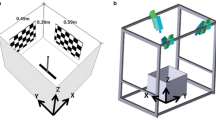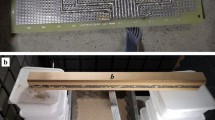Abstract
-
1.
The European hawk moth Macroglossum stellatarum, while collecting nectar in hovering flight in front of flowers, follows moving stripe patterns in the lateral visual field. This response counteracts a second one, that is the animals' effort to stabilize their distance from dummy flowers. We investigated the response to motion stimuli in the lateral visual field using sinusoidally oscillating stripe patterns (Fig. 1), as well as its interaction with the distance stabilizing response.
-
2.
In both responses moths attempt to compensate for image speed. The balance between the two depends on the number of elementary motion detectors stimulated by the dummy flower and the stripe pattern, respectively. Increasing the diameter of the dummy flower (Figs. 2 to 4) or the spatial frequency of the stripe pattern (Fig. 7) shifts the balance in favour of distance stabilization. The reverse is true when the length of the stripes in the pattern (Fig. 5) or their number is increased (Fig. 6). It does not matter whether the stripe pattern is presented in the lateral (Fig. 4A) or in the dorsal and ventral visual field (Fig. 4B).
-
3.
The gain-frequency relations of the response to the lateral stripe pattern obtained with dummies in two different positions within the drum have their maxima around 3 Hz and decline rapidly towards lower and higher frequencies like the response of a bandpass filter. The distance stabilizing response also has bandpass properties, but with a broad plateau between 0.15 and 5 Hz (Fig. 8). The most likely explanation for this difference is that there is a regional or direction-dependent variation of motion detector properties.
-
4.
The responses to ramp-like stimuli are phasic in accordance with the amplitude frequency characteristics, but the responses to progressive (front to back) and regressive motion of the pattern differ (Figs 9, 10).
-
5.
The response appears to depend on the azimuthal position of the stripe pattern within the visual field (Fig. 11). It is strongest when the pattern covers equally large parts of the frontal and caudal visual fields. The optomotor sensitivity to translational pattern motion is higher in the frontal than in the caudal visual field (Fig. 12, Table 1).
-
6.
When the stripe pattern on one side is removed, the response amplitude is halved. There is no detectable turning response around the vertical axis to the oscillation of the stripe pattern (Fig. 13, Table 2).
-
7.
The possible role of the response to pattern movements parallel to the longitudinal body axis under natural conditions is discussed.
Similar content being viewed by others
Abbreviations
- DCR :
-
drift compensating response
- DSR :
-
distance stabilizing response
- EMD :
-
elementary motion detector
References
Bartsch K, Warrant EJ (1994) The nonspherical superposition eye of Macroglossum stellatarum (Lepidoptera, sphingidae). In: Elsner N, Breer H (eds) Göttingen Neurobiology Report 1994. Thieme, Stuttgart New York
Burchner E (1984) Behavioural analysis of spatial vision in insects. In: Ali MA (ed) Photoreception and vision in insects. Plenum Press, New York London, pp 561–621
Collett TS (1980a) Some operating rules for the optomotor system of a hoverfly during voluntary flight. J Comp Physiol 138: 271–282
Collett TS (1980b) Angular tracking and the optomotor response. An analysis of visual reflex interaction in a hoverfly. J Comp Physiol 140: 145–158
Collett TS, Land MF (1975) Visual control of flight behviour in the hoverfly, Syritta pipiens L. J Comp Physiol 99: 1–66
Egelhaaf M (1987) Dynamic properties of two control systems underlying visually guided truning in house-flies. J Comp Physiol A 161: 777–783
Egelhaaf M, Borst A (1993) Movement detection in Arthropods. In: Miles FA, Wallman J (eds) Visual motion and its role in the stabilization of gaze. Elsevier, Amsterdam London New York, 53–77
Farina WM, Varjú D (1993) The response of the hawk moth Macroglossum stellatrum to translatory movements of stripe pattern. In: Elsner N, Heisenberg M (eds) Gene-Brain-Behaviour. Thieme, Stuttgart New York, p 370
Farina WM, Varjú D, Zhou Y (1994) The regulation of distance to dummy flowers duirng hovering flight in hawk moth Macroglossum stellatarum. J Comp Physiol A 174: 239–247
Götz KG (1975) The optomotor equilibrium of the Drosophila navigation system. J Comp Physiol 99: 187–215
Holst E von, Mittelstaedt H (1950) Das Reafferenzprinzip (Wechselwirkung zwischen Zentralnervensystem und Peripherie). Naturwissenschaften 37: 564–476
Junger W, Dahmen HU (1991) Response to self-motion in waterstriders: visual discrimination between rotation and translation. J Comp Physiol A 169: 641–666
Junger W, Varjú D (1990) Drift compensation and its sensory basis in waterstriders (Gerris paludum F.). J Comp Physiol A 167: 441–456
Kelber A (1993) Visuelle Orientierung im Fluge: Die schwebenden Wächterinnen der stachellosen Biene Tetragonisca angustula (Meliponinae, Hymenoptera). Dissertation Universität Tübingen
Kelber A, Zeil J (1990) A robust procedure for visual stabilisation of hovering flight position in guard bees (Trigona (Tetragonisca angustula, Meloponinae). J Comp Physiol A 167: 569–577
Kern R (1993) The response of the hawk moth Macroglossum stellatarum L. to translatory, rotatory, and combined visual stimulation. In: Elsner N, Heisenberg M (eds) Gener-Brain-Behaviour. Thieme, Stuttgart New York, p 367
Kern R, Varjú D (1994) Flow-field analysis by means of eye region specialisation: Free-flight experiments in the hawk moth Macroglossum. In: Elsner N, Breer H (eds) Göttingen Neurobiology Report 1994. Tieme, Stuttgart New York, p 435
Koenderink JJ, Doom AJ van (1987) Facts on optic flow. Biol. Cybern 56: 247–254
Kramer D, Varjú D (1991) Velocity compensation in the hawk moth Macroglossum to vertical stripe patterns moving parallel to the longitudinal body axis. Verh Dtsch Zool Ges 84, p 351
Land MF (1992) Visual tracking and pursiut: humans and arthropods compared. J Insect Physiol 38: 939–951
Land MF, Collett TS (1974) Chasing behaviour of houseflies (Fannia canicularis). A description and analysis. J Comp Physiol 89: 331–357
Lazzari C, Varjú D (1990) Visual lateral fixation in the haematophagous bug Triatoma infestans. J Comp Physiol A 167: 527–531
Paul H, Nalbach HO, Varjú D (1990) Eye movements in the rock crab Pachygrapsus marmoratus walking along straight and curved paths. J Exp Biol 154: 81–97
Pfaff M, Varjú D (1991) Machanisms of visual distance perception in the hawk moth Macroglossum stellatarum. Zool Jb Physiol 95: 315–321
Preiss R (1991) Separation of translation and roatation by means of eye-region specialization. J Insect Behav 4: 209–219
Reichardt W (1973) Musterinduzierte Flugorientierung. Verhaltensversuche an der Fliege Musca domestica. Naturwissenschaften 60: 122–138
Reichardt W, Varjú D (1959) Übertragungseigenschaften im Auswertesystem für das Bewegungssehen (Folgerungen aus Experimenten an dem Rüsselkäfer Chlorophanus viridis). Z Naturforsch 14b: 674–689
Srinivasan MV, Lehrer M, Kirchner W, Zhang SW (1991) Range perception through apparent image speed in freely-flying honeybees. Visual Neurosci 6: 519–535
Varjú D (1959) Optomotorische Reaktionen auf die Bewegung periodischer Helligkeistmuster. Z Naturforsch 14b: 724–735
Varjú D (1973) Übertragungseigenschaften im Auswertesystem für das Bewegungssehen. In: Lueken B, Scharf JH (eds) Neue Ergebnisse zur Informationsaufnahme und Informationsverarbeitung in Sinnesorganen. Nova Acta Leopoldina, Neue Folge, 37/2: 173–193
Varjú D (1975) Stationary and dynamic responses during visual edge fixation by a walking insect. Nature 255: 330–332
Varjú D (1977) Systemtheorie für Biologen und Mediziner. Springer, Berlin Heidelberg New York, pp 134–138
Varjú D (1987) The interaction between visual edge fixation and skototaxis in the mealworm beetle Tenebrio molitor. J Comp Physiol A 160: 543–552
Varjú D (1990) A note on the reafference principle. Biol. Cybern 63: 315–323
Wehner R (1981) Spatial vision in Arthropods. In: Autrum H (ed) Comparative physiology and evolution of vision in invertebrates (Handbook of sensory physiology, vol IIV/6C). Springer, Berlin Heidelberg New York, pp 187–218
Wehrhahn Ch (1985) Visual guidance of flies during flight In: Kerkut GA, Gilbert LI (eds) Comprehensive insect physiology, biochemistry and pharamology, Vol 6. Pergamon Press, Oxford New York Toronto Sydney Paris Frankfurt, 673–687
Wehrhahn Ch, Hausen K (1980) How is tracking and fixation accomplished in the nervous system of the fly? Biol Cybern 38: 179–186
Wicklein M (1994) Neuroanatomie der optischen Ganglien und Electrophysiologie bewegungssensitiver interneurone in der Lobula Platte von Macroglossum stellatarum. Dissertation Universität Tübingen
Zanker J, Collett TS (1985) The optomotor system on the ground: on the absence of visual control of speed in walking ladybirds. J Comp Physiol A156: 395–402
Zeil J (1983) Sexual dimorphism in the visual system of flies: The free flight behaviour of male Bibionidae (Diptera). J Comp Physiol 150: 395–412
Zeil J (1986) The territorial flight of male houseflies (Fannia canicularis L. ). Behav Ecol Sociobiol 19: 213–219
Author information
Authors and Affiliations
Rights and permissions
About this article
Cite this article
Farina, W.M., Kramer, D. & Varjú, D. The response of the hovering hawk moth Macroglossum stellatarum to translatory pattern motion. J Comp Physiol A 176, 551–562 (1995). https://doi.org/10.1007/BF00196420
Accepted:
Issue Date:
DOI: https://doi.org/10.1007/BF00196420




